A Comprehensive Guide to Subscription Based Healthcare: What You Required to Know
A Comprehensive Guide to Subscription Based Healthcare: What You Required to Know
Blog Article
Understanding the Cost-Effectiveness of Subscription-Based Medical Care Versions
As the healthcare landscape evolves, subscription-based models become a compelling choice, assuring to redefine exactly how individuals take care of medical expenditures. Assessing these designs' cost-effectiveness necessitates a nuanced contrast with conventional insurance, taking into consideration both financial implications and patient contentment. While they supply transparency and predictability in costs, inquiries continue to be regarding their ability to satisfy varied medical care demands, especially for specialized therapies. The point of views of doctor better complicate this formula, offering a multifaceted difficulty. What does the future hold for these versions, and can they really provide on their assurance of easily accessible, affordable care?
Introduction of Subscription-Based Versions
Subscription-based medical care designs, sometimes described as direct health care or attendant medicine, are increasingly getting attention as a potential solution to ineffectiveness within standard healthcare systems. These versions operate the principle of offering people direct accessibility to medical care suppliers with a yearly or month-to-month charge, bypassing the demand for standard insurance coverage devices. This arrangement intends to streamline patient-provider communications by reducing management problems, which typically impede tailored and timely care.
At the core of subscription-based models is the emphasis on a more personalized person experience. Patients take advantage of improved access to their physicians, frequently consisting of next-day or same-day visits, extended consultation times, and straight communication channels such as phone or video telephone calls. This model cultivates an aggressive method to healthcare, where providers and patients can collaboratively concentrate on preventative treatment and chronic condition management.

Price Contrast With Conventional Insurance

One of the key monetary benefits of membership versions is transparency in prices. Individuals pay a predictable cost, which can simplify budgeting and monetary planning. In addition, these models normally eliminate co-pays and deductibles for protected solutions, lowering out-of-pocket costs. Alternatively, traditional insurance coverage may be much more useful for individuals calling for specialized treatment or pricey treatments not covered under a registration model, as they take advantage of the more comprehensive insurance coverage network and cost-sharing devices.
Nevertheless, cost-effectiveness is context-dependent. While subscription versions may offer financial savings for those mainly requiring key care, people with persistent problems or specialized healthcare needs might discover conventional insurance policy more comprehensive. As a result, reviewing particular medical care needs and prospective usage is essential in identifying the most cost-effective choice for individuals.
Effect On Individual Complete Satisfaction
Person complete satisfaction within subscription-based medical care designs typically mirrors a considerable renovation over traditional insurance policy systems. Unlike conventional systems, where patients could experience delays in obtaining treatment, subscription-based designs guarantee more straight and prompt interactions with health care carriers.
In addition, the openness in expenses related to subscription-based healthcare alleviates the common frustrations connected to unexpected fees and complicated billing processes seen in conventional insurance policy (subscription based healthcare). Patients value understanding the precise monetary dedication upfront, resulting in enhanced depend on and confidence in their healthcare monitoring
Furthermore, the emphasis on preventative care and wellness in registration designs adds to improved health results, better enhancing patient contentment. By concentrating on recurring health care instead of episodic treatment, people experience an even more alternative and continuous health care journey.
In addition, the enhanced provider-patient relationship promoted in these versions, characterized by more time spent per individual and tailored interest, plays an essential role in elevating individual complete satisfaction levels, as people feel truly looked after and comprehended.
Provider Viewpoints and Experiences
From the supplier's point of view, subscription-based medical care versions supply a transformative method to supplying clinical solutions. These versions emphasize a preventative and proactive health care technique, enabling suppliers to concentrate on thorough individual treatment without the constraints of standard fee-for-service setups (subscription based healthcare). This change in emphasis typically causes enhanced individual outcomes and increased supplier contentment, as healthcare specialists can designate more time and sources to client engagement and personalized care strategies
In addition, membership designs assist in foreseeable earnings streams, which enhance economic stability for doctor. This predictability enables boosted source planning and allowance, adding to an extra reliable healthcare shipment system. Companies can buy team training, infrastructure, and innovation enhancements, thus improving the quality of treatment offered.
However, the shift to subscription-based versions is not without difficulties. In spite of these hurdles, many suppliers find that the benefits of boosted client interaction and streamlined operations outweigh the first challenges, making subscription-based models an eye-catching choice.
Future Prospects and Challenges

A key challenge is regulatory compliance, as membership models must stick to evolving medical care plans and insurance needs. This requires continuous adjustment and advancement to make certain positioning with legal requirements. In addition, incorporating these models into existing health care frameworks can be complicated, requiring considerable financial investments in modern technology and training.
There is likewise the possible risk of producing injustices in medical care accessibility, as registration designs may prefer those that can manage them, leaving susceptible populations underserved. Source Addressing this calls for thoughtful factor you can look here to consider of pricing methods and subsidy devices to ensure inclusivity.
Final Thought
Subscription-based healthcare models present a feasible choice to traditional insurance by providing monetary predictability and openness, especially benefiting people with persistent problems or constant medical care demands. The cost-effectiveness of these versions rests upon specific health care use patterns and scenarios. While they might boost individual fulfillment and simplify budgeting, challenges continue to be in addressing specialized treatment requirements. Future factors to consider consist of stabilizing detailed coverage with affordability and integrating these models within the wider healthcare system for ideal outcomes.
Subscription-based medical care versions, often referred to as straight main treatment or concierge medication, are progressively getting attention as a potential option to ineffectiveness within typical medical care systems. Unlike traditional systems, where individuals might experience delays in receiving treatment, subscription-based models make certain more prompt and direct communications with healthcare service providers.
These designs emphasize a proactive and preventative healthcare approach, permitting suppliers to focus on thorough patient care without the restrictions of standard fee-for-service plans. As these versions continue to acquire traction, they use the prospective to revolutionize individual access to care, simplify solution delivery, and enhance health care investing.Subscription-based health care versions offer a practical option to traditional insurance by using monetary predictability and transparency, especially benefiting people with persistent conditions or regular here health care needs.
Report this page